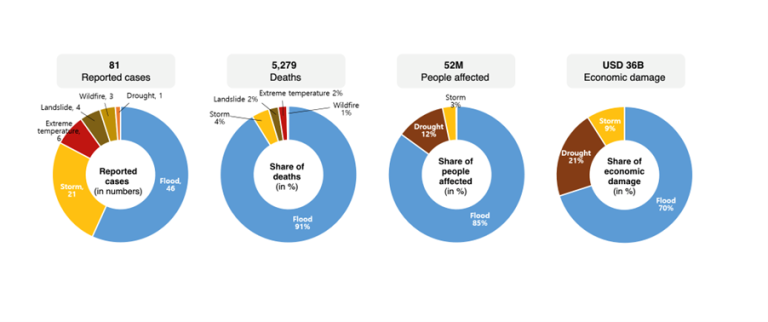Climate change impacts increase in Asia
Bangkok, Thailand - Extreme weather and climate change impacts are increasing in Asia, which ricocheted between droughts and floods in 2022, ruining lives and destroying livelihoods. Melting ice and glaciers and rising sea levels threaten more socio-economic disruption in future, according to a new report from the World Meteorological Organization.

Asia, the continent with the largest land mass extending to the Arctic, is warming faster than the global average. The warming trend in Asia in 1991–2022 was almost double the warming trend in the 1961–1990 period, according to the WMO State of the Climate in Asia 2022 report.
There were 81 weather, climate and water-related disasters in Asia in 2022, of which over 83% were flood and storm events. More than 5 000 people lost their lives, more than 50 million people were directly affected and there were more than US$ 36 billion in economic damages, according to the report. In addition, a large part of arid Asia experienced severe dust storms. Several severe dust storm events in western Asia affected civil lives in the region.
“This report summarizes the state of the climate and the extreme events and their socioeconomic impacts in Asia in 2022. In 2022, many areas in Asia experienced drier-than-normal conditions and drought. China, in particular, suffered prolonged drought conditions, which affected water availability and the power supply. The estimated economic losses from the drought affecting many regions in China were over US$ 7.6 billion. Pakistan, by contrast suffered disastrous flooding,” said WMO Secretary-General Prof. Petteri Taalas.
“Most glaciers in the High Mountain Asia region suffered from intense mass loss as a result of exceptionally warm and dry conditions in 2022. This will have major implications for future food and water security and ecosystems,” he said.

The report, one of a series of WMO regional State of the Climate reports, was released during a meeting of the UN Economic and Social Commission for Asia and the Pacific’s (ESCAP) Committee on Disaster Risk Reduction.
“The United Nations Secretary-General’s “Executive Action Plan on Early Warnings for All,” co-led in implementation by WMO and the United Nations Office for Disaster Risk Reduction (UNDRR), is more critical in Asia, which is the world’s most disaster-impacted region and where the effects of transboundary climate-related disasters are on the rise,” said Armida Salsiah Alisjahbana Under-Secretary-General of the United Nations and Executive Secretary of ESCAP.
The report is accompanied by an interactive story map, with a special focus on agriculture and food security. The expected increase in the frequency and severity of extreme events over much of Asia will impact agriculture, which is central to all climate adaptation planning.
“Impact-based forecasting, early warnings for all, and their translation into anticipatory action are examples of the transformative adaptation needed to strengthen the resilience of food systems in Asia,” said Ms. Salsiah Alisjahbana
- Region:
- Region II: Asia










